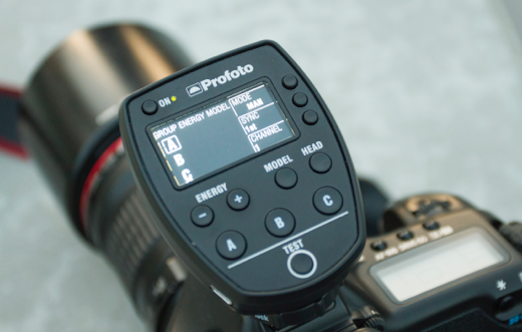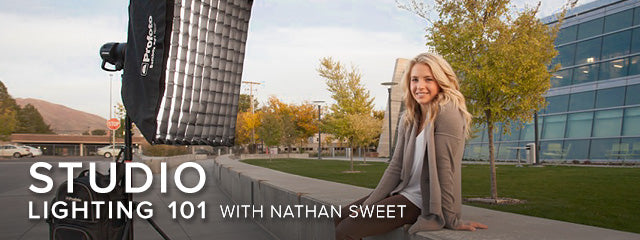Using studio lights can be extremely intimidating for anyone who has never had experience using flash with photography. Strobe lighting can completely transform a dull image into a beautiful work of art. The most important thing to understand about lighting is that it's the core of photography; light is what creates a photograph. It is essential, so why not use it to your advantage?
By using strobe lighting in your images, you're adding light that shouldn't - or couldn't - have normally existed in the picture, which allows you to become creative beyond even your own imagination. To do this, we will look at important components to creating a beautiful portrait and how we accomplished it!
 © Nathan Sweet
© Nathan SweetFirst, the best advice I can give you would be to invest in a good light system. A great strobe can give you the confidence you need to get the shot you want. Buy purchasing light modifiers that are good quality you're giving yourself the assurance of knowing the strobe will go off each time you take the picture as well as knowing you will get the same shape of light every single time the strobe flashes. So what are the components of a good lighting system?
 TRIGGER: Profoto TTL air controller connects to your camera and allows you to wirelessly control the flashes power through your camera. A simple and easy-to-use controller with a large display will allow you to see TTL ratios of lights and quickly adjust for a more efficient and swift photo session. The unit has a solid connection to your hot shoe of your camera insuring your flash will fire each time you take a picture.
TRIGGER: Profoto TTL air controller connects to your camera and allows you to wirelessly control the flashes power through your camera. A simple and easy-to-use controller with a large display will allow you to see TTL ratios of lights and quickly adjust for a more efficient and swift photo session. The unit has a solid connection to your hot shoe of your camera insuring your flash will fire each time you take a picture.
 STROBE: By using a Profoto strobe you'll know that every picture you take will have the same flash output, as well as the same white balance consistency between every picture. Being able to control your flash power within 1/10 of a stop provides confidence you can feather in a touch of light to any shot adding dynamic shape in your picture. The Profoto B1 is wirelessly battery powered allowing you to work freely without cords or battery packs.
STROBE: By using a Profoto strobe you'll know that every picture you take will have the same flash output, as well as the same white balance consistency between every picture. Being able to control your flash power within 1/10 of a stop provides confidence you can feather in a touch of light to any shot adding dynamic shape in your picture. The Profoto B1 is wirelessly battery powered allowing you to work freely without cords or battery packs.
 SOFT BOX: The quality of a light modifier can be over looked , but an initial investment can save you from headache later on. Profoto softbox rings are equipped with strong clamps around the connection point making the modifier feel like one with the strobe itself. With strong, but flexible rods and durable fabric for the softbox, you’ll get a consistent shape of light every single shoot. Your investment will last because the fabric used to make the softbox is archival-treated, meaning your white fabric will not turn yellow over time and the silver lining of the softbox will keep its reflective quality.
SOFT BOX: The quality of a light modifier can be over looked , but an initial investment can save you from headache later on. Profoto softbox rings are equipped with strong clamps around the connection point making the modifier feel like one with the strobe itself. With strong, but flexible rods and durable fabric for the softbox, you’ll get a consistent shape of light every single shoot. Your investment will last because the fabric used to make the softbox is archival-treated, meaning your white fabric will not turn yellow over time and the silver lining of the softbox will keep its reflective quality.
GRIDS: A grid seems like something weird that only professional photographers use because honestly, what do they even do? The grid is attached to the front of the light modifier, and effects the spill light. In other words, the grid doesn't affect the softness of light, just the light shape. Using a grid allows you to hit the subject with just the right amount of light without letting the strobe illuminate objects around your subject, allowing you more control of your lighting. This will help you have more control over your lighting!
How To Use a Strobe:
While using a strobe can be complex and sometimes frustrating, my personal experience has been by keeping it simple, you will receive the best results. I first begin the shoot by getting everything setup, and before I even turn on the strobe, I figure out my ambient light exposure. This part is really easy, because you probably already know how to properly expose a setting with your camera. Next step is determining how much strobe lighting to add. Understand that your shutter can be faster than your sync speed, usually 1/200th of a second for most DSLR cameras. Once I've determined my exposure, I generally drop my exposure ½ to 1 stop to make the photograph dramatic. I personally drop my exposure with aperture or ISO, though its personal preference; you can figure out what works best for you through trial-and-error.
What is Sync Speed?
Sync speed refers to the fastest shutter speed you can use with the flash. If you take too quick a picture (fast shutter) it doesn't give enough time for the flash to strobe.
Add your strobe light:
By using a strobe with a soft light modifier, like a soft box, you can give the photograph a soft, beautiful look. The soft box is placed at a 45º to the left of the model with a grid on it. This will help the light not illuminate everything around her.
(The picture to the right is 1/3 stop under exposed, the sun is setting to the right, the model hasn't "popped" yet; something is missing.)
 Left: 1/3 stop under exposed with the sun setting to the right Lacks 'pop.' Right: Correct exposure was added with strobe, image looks better.
Left: 1/3 stop under exposed with the sun setting to the right Lacks 'pop.' Right: Correct exposure was added with strobe, image looks better.Finding the right power setting:
This is where trial and error will come into play or use the new TTL feature with the Profoto B1 strobes. If you use TTL you won't have to worry about exposure settings, the camera and strobe will work together and figure out the right power level for the light.
Turn the strobe on and set it to the lowest power level "2.0" and take a picture. If you don’t notice the flash in your picture turn the power up to a "3" or a "5" and take a second picture. One you start to see the strobe light complement the shadows in your original picture you’re now working with strobes! Seem simple enough?

